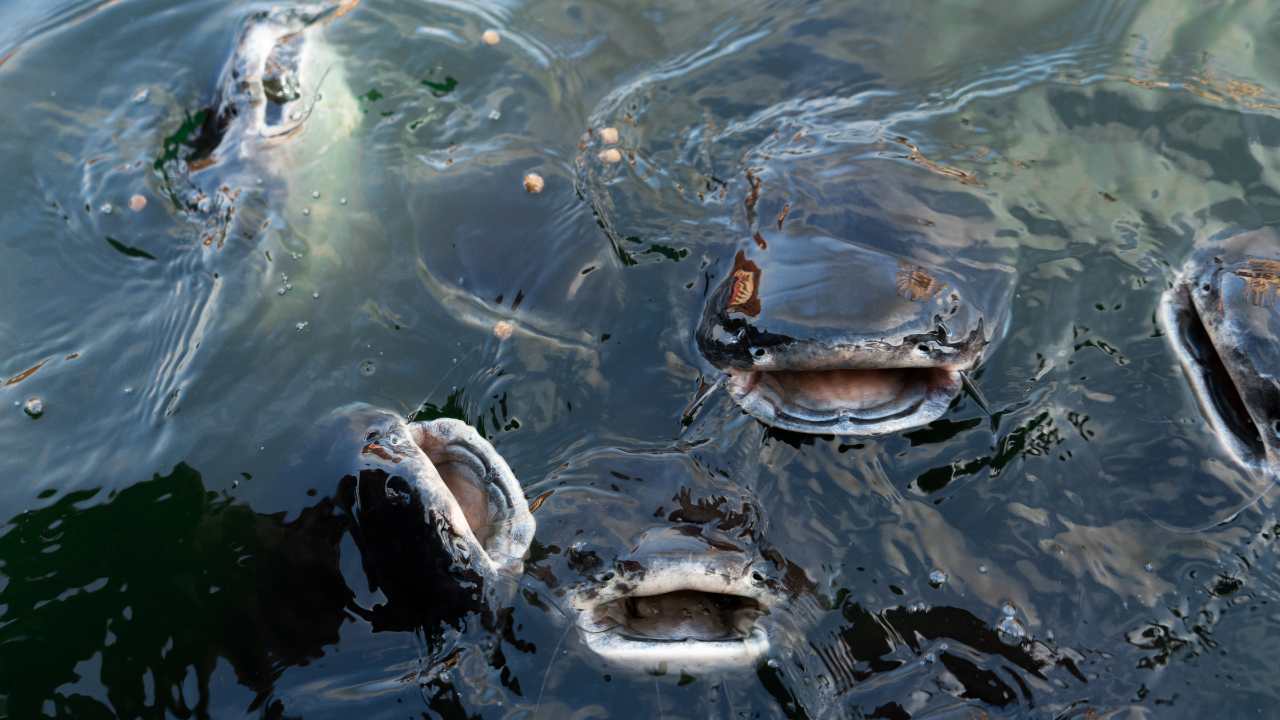Global ecosystems are changing quickly due to climate change, and catfish are only one of the numerous species that are being impacted. These tough and adaptable fish, which may be found in a variety of settings like the Amazon River, African lakes, and Asian rice fields, are dealing with never-before-seen difficulties because of rising pollution, fluctuating temperatures, and changing water levels. Catfish populations are under pressure to adapt or face extinction as a result of rising global temperatures and increasingly unpredictable weather. This article will look at the particular effects of climate change on catfish populations around the world, as well as the particular difficulties they encounter and the conservation initiatives being implemented to save these important species.
Catfish’s Place in Aquatic Ecosystems

In order to keep aquatic ecosystems in balance, catfish are essential. They are frequently important scavengers and predators that break down organic materials and aid in the management of fish and aquatic organism populations. Several species of catfish, which are bottom-dwellers, improve the health and cleanliness of their environments by eating algae, insects, and other debris. They also provide a significant food source for larger predators, such as animals, birds, and even people. Owing to their crucial function, any disturbance in the populations of catfish can have a ripple impact on the ecosystem as a whole.
An Increasing Danger to Catfish Due to Rising Water Temperatures
The rise in water temperatures is one of the most direct effects of climate change on catfish populations. Numerous species of catfish are ectothermic, meaning that their environment controls their body temperature. The rise in global temperatures has an impact on water temperatures, which in turn affects catfish growth, metabolic rates, and reproductive success. Increased metabolism from warmer waters can result in a greater requirement for food. But since warming also affects aquatic ecosystems, fewer food sources may be available, which would put catfish populations under more stress and competition.
Even little increases in temperature can cause many catfish species to reach their tolerance limits in tropical and subtropical climates, where water temperatures are already high. For example, the Mekong River, which has already been affected by habitat loss and dam development, is home to one of the largest freshwater species in the world, the Mekong Giant Catfish, which is especially vulnerable to rising temperatures. Raised water temperatures have the potential to lower dissolved oxygen concentrations, further straining the fish and perhaps causing die-offs.
Modified Patterns of Rainfall and Water Levels

Additionally, more unpredictable and extreme rainfall patterns brought on by climate change result in both flooding and droughts, which have an immediate impact on the habitats of catfish. Catfish populations may be negatively impacted by habitat disruption caused by changes in river flow, sedimentation, and water quality in areas where floods are occurring more frequently. Although some species of catfish have evolved to live in flood-prone environments, regular and intense floods can wash away eggs and young fish, decrease the success of spawning, and raise the danger of predation.
On the other hand, protracted droughts may result in lower water levels, which may expose catfish to predators and limit their habitat. Long-term droughts have been demonstrated to dramatically lower water levels in the Amazon Basin, which raises pollution concentrations and lowers oxygen levels. Catfish species that depend on big, clean bodies of water to survive, like the Redtail Catfish, are seriously threatened by this scenario.
The Effects of Ocean Acidification on Species of Catfish
The majority of catfish species live in freshwater, however some standout exceptions include the Hardhead Catfish, which is found in estuaries and coastal areas. The additional concern to these catfish is ocean acidification, which is a direct result of rising atmospheric carbon dioxide levels. The availability of calcium carbonate is decreased by ocean acidification, which is detrimental to the formation of shells and skeletal structures in many marine animals. Acidification can affect the growth rates, reproductive success, and sensory perception of catfish living in brackish waters or coastal locations. The availability of prey species can be impacted by pH changes in the water, which can further modify the food chain and the ecological function of catfish in certain settings.
Degradation of Habitat and Pollution: Twofold Problems for Catfish

Catfish populations are still seriously threatened by pollution and habitat damage in addition to climate change. Many river systems are now fragmented due to deforestation, agricultural expansion, and dam construction, which has reduced the amount of acceptable habitat for catfish species. Catfish populations are further stressed by the lack of habitat as well as contamination from pesticides, plastic debris, and industrial runoff.
For instance, the Mekong Delta in Southeast Asia is home to the highly farmed Pangasius catfish, which suffers from pollution and habitat destruction. This species is very susceptible to the negative effects of water pollution on its growth and well-being. Moreover, pollution can impact catfish physiology and reproduction by decreasing the amount of available prey and raising the concentration of dangerous materials including heavy metals and microplastics.
Disease Transmission and Invasive Species
In addition to changing aquatic ecosystems, climate change has the potential to foster the spread of invasive species and diseases. Warmer waters have the potential to enhance the prevalence of diseases, including bacteria, fungus, and parasites, that harm catfish. These infections can induce illnesses that lower development rates, weaken immune systems, and cause large-scale catfish population declines. For example, outbreaks of infections like columnaris and enteric septicemia, which are made worse by warmer water temperatures, have impacted the Channel Catfish, a popular species in North America.
Additionally, as a result of climate change, invasive species may be able to spread farther and compete with native catfish for resources. In many instances, invading species can outcompete or prey on native catfish because they are more adapted to shifting environmental factors. The invasive armored catfish, for example, is a serious danger to native species in South America because it has altered ecosystems and outcompeted them for food and space.
Strategies for Adaptation and Conservation
Worldwide, a number of conservation initiatives are being carried out to lessen the effects of climate change on catfish populations. These initiatives cover sustainable fishing methods, pollution reduction, and habitat restoration. For instance, there are programs in place in the US to restore wetlands and rivers in order to give animals like blue catfish better homes. Organizations in Southeast Asia are attempting to preserve vital breeding grounds for the critically endangered Mekong Giant Catfish as well as enhance the river’s water quality.
Additionally, aquaculture methods are being modified to address climate change. To create catfish strains that are more tolerant to disease pressure and greater temperatures, farmers are turning to selective breeding techniques. Furthermore, enhanced water management and surveillance mechanisms are being executed to guarantee ideal circumstances for catfish raised in aquaculture, diminishing the possibility of widespread mortality and illness incidents.
The Significance of Education and Community Participation
Catfish population conservation heavily relies on community involvement and education. To guarantee the success of conservation measures, local communities—especially those who depend on catfish for food and a living—must be included. Education initiatives that highlight how climate change affects aquatic habitats can promote sustainable practices and a sense of responsibility in participants. For instance, community-led projects in Asia and Africa have effectively encouraged the use of environmentally friendly fishing gear, decreased pollution, and preserved important catfish habitats.
Catfish’s Future in a Changing World
The extent to which we can successfully minimize the effects of climate change and save their habitats will determine the future of catfish populations worldwide. Although catfish are renowned for their adaptability and resistance, the quickening speed of climate change brings forth new difficulties that demand immediate attention. There is hope for the survival of these significant species when conservation initiatives are paired with community involvement and sustainable management strategies.
Protecting catfish and their habitats must be our top priority as we investigate and comprehend the intricate relationships between climate change and aquatic ecosystems. By doing this, we can guarantee the viability of the economies and communities that depend on these amazing fish as well as the preservation of the planet’s biodiversity.
An Appeal for Group Action
There is no denying the effects of climate change on catfish populations. Catfish suffer many threats to their survival, such as habitat degradation and rising water temperatures. But we can contribute to preserving these rare and important species for future generations by raising awareness and implementing sustainable practices and coordinated conservation efforts. In order to guarantee a sustainable future for catfish and the ecosystems they live in, governments, organizations, communities, and individuals must work together. The moment to act is now.





